A Portrait of an Artist as a Father
“Yeah I’m still here, thumbing through the book that you left
A hundred different symbols, I always wondered what they meant.
A circle, a jagged edge, a cross
Holding little bits of the truth
Whatever I may be hiding
I think that I could show it to you”
–“Strange Wind,” Poe
In my last dream of my father, I am with my sister Diwata. We are in his Baguio house, packing his things. We are talking about how much we miss him when my sister suddenly sees him sitting on his bed, beside his paintings.
I am overjoyed, I call out to him. “Dad!” Diwata is skeptical and says we are just seeing things. But my father speaks up and says,”No, it’s me, you see? Give me a hug if you like.” So we do. We tell him we love him. And he changes; when we first see him, he is young and healthy, in his 40s. Then he whips out a notebook, and he is bald again, with a big tummy and crusty lips. He looks just like he did before he died at 53. He starts drawing frantically: he spells out “marginalize” and “minimize.” He shows me drawings of skulls.
He mutters, “Meron pa to, eh. Meron pa!” (“There is more here, there is more!”) And he’s drawing faster, tracing pen over paper, dotting lines and shadows. And then he tells me, indignantly, “Can you believe someone [in the other world, where he is] told me that there is no process to art? That it just comes out when you get inspired? I got insulted, like he just negated my whole life’s work!”
So I ask, “Well, don’t you get to do art anyway?” He looks up from his frantic scribbling and asks, “Where?” I replied, “In heaven, where you are.” And he just stares at me sadly. He doesn’t reply. And then I wake up.
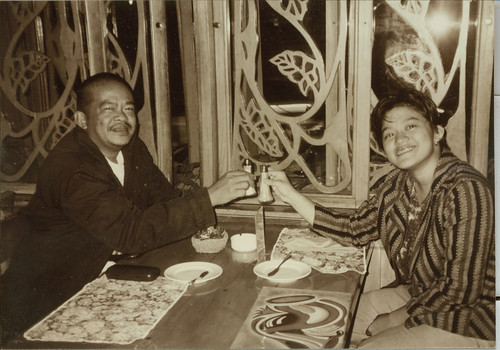
Death
When my dad died just a little more than a year ago, nobody expected it. Even though he had gone th rough two strokes, high blood pressure, gallstones, sinus problems, and complained,”Kumakain lang ako ng gamot (I am just eating medicine)!” he seemed strong. He was working on five paintings at a time. He finished an interview with the NCCA about his friend Robert Villanueva. He was putting up a new arts organization, Fish Eye. He was looking forward to going to spending his residency in Barcelona. He had just won the Maynila award.
rough two strokes, high blood pressure, gallstones, sinus problems, and complained,”Kumakain lang ako ng gamot (I am just eating medicine)!” he seemed strong. He was working on five paintings at a time. He finished an interview with the NCCA about his friend Robert Villanueva. He was putting up a new arts organization, Fish Eye. He was looking forward to going to spending his residency in Barcelona. He had just won the Maynila award.
Everyone knew his health was failing, but no one expected him to die. Except for him: In his emails to other people he would write: “I keep reinventing myself because art is long, life is short.” He urged his publisher to write a book on his work.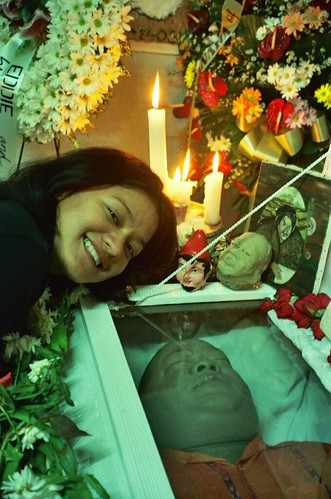
We took a ten-hour road trip to Vigan and passed by Juan Luna’s house. On our way home he told me to turn his house into a museum when he died. “You can put freeze Ino (his houseboy) in the kitchen,” he cackled. “Preserve everything!” What he wanted was 10 more years, to paint a hundred more paintings.
Instead, he died on the last day of the Baguio Arts Festival, held by the Baguio Arts Guild (BAG). My father co-founded and led BAG for many years; he was instrumental in turning Baguio into the renowned arts center it is now. Intrigue and politics resulted in his resignation from the Guild and his exclusion from the Festival in 2002. Although his death certificate says multiple organ failure, people would later say he died of a broken heart.
I don’t remember who told me my dad was dead. My mom called me at work and said they were picking me up to go to Baguio. “Baka hindi na natin maabutan ang daddy mo (We might not get to your dad in time).” Baguio was eight hours away. I was scared, but I did not think he would die.
The last time he had a stroke, he was calling us every five minutes to ask, “Asan na kayo? Ang tagal nyo naman (Where are you? You are taking too long)!” It was a testament to his kakulitan. My mom and my sisters had just left the house when they received a call from my father’s doctor.
This time, my dad did not make it. It was our saddest, longest drive to Baguio.
On our way up, we intermittently sobbed and cracked jokes about my father. “Kakainis talaga daddy nyo, laging nagmamadali (Your dad is so annoying, always in a hurry),” my mom said. Diwata knew he was scared of death, and kept crying. She said, “I just feel bad that we weren’t there to hold his hand in his last moments. That he was all alone on his deathbed.”
But we were wrong. He was not alone.
When we finally arrived in Baguio at 10 p.m. in the evening, the hospital had at least twenty people—all friends and family—waiting for us. People he worked with in the Guild, my cousins, people who loved and admired him. They had watched over my dad, had stayed with him in his last moments.
We were together in our grief, love and disbelief. In the morgue I took one look at my dad and laughed out loud. He looked like Mang Kepweng–cotton in his nostrils, a hanky around his face. Many years ago, he staged an art performance of a mock faith healing. I whispered to him, “Niloloko mo naman kami, eh (You’re just tricking us).”
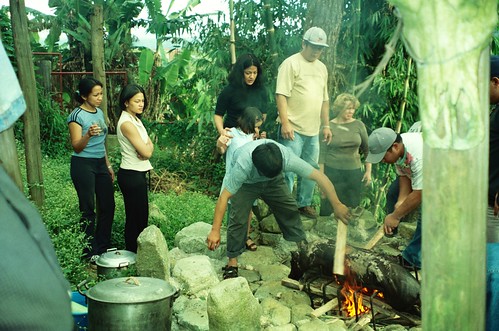
We held the wake in our Quezon Hill home for three days. Friends from all over, indistinguishable from family, grieved with us. Boyu prepared his altar, burned incense and made some offerings. Bencab gave my dad a canao. On the last night, we closed the road his house was on–Cut-off Road—and erected a stage. It was his farewell street party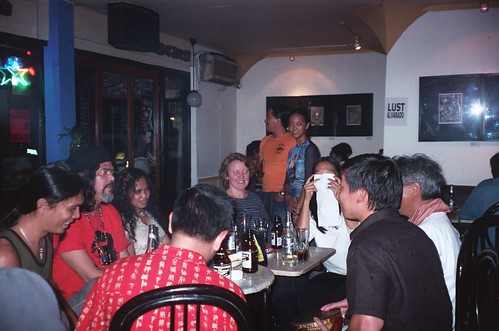 .
.
We all celebrated his life and his art by telling Santi anecdotes. My sister Mutya and I sang for him. Congressman Domogan, who was also his friend, chanted a beautiful eulogy in his dialect. Artists: painters, sculptors, singers , dancers, writers, grade school and high school classmates, college friends, art patrons, former office mates, paid tribute. We drank too much, we smoked too much, we ate too much. It was a fitting tribute—by night’s end, everyone was hugging.
My dad wanted to be cremated, or have his body thrown into the sea. He joked about having his friends smoke his ashes in a joint. There were other, also-fitting tributes: they did not end with the canaos and the parties on the street. On the ninth day, another touching ceremony was held at the CCP care of Kim Atienza and Sid Hildawa.. On the 40th day of his death, when his soul was believed to have passed o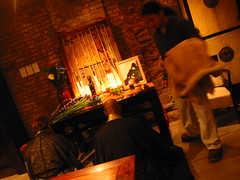 n to the other world, we celebrated at Penguin Cafe, with Pinikpikan providing the music and good vibes.
n to the other world, we celebrated at Penguin Cafe, with Pinikpikan providing the music and good vibes.
We announced that we put my father’s ashes in the dalandan punch, instead of rolling them up in a joint. Everyone drank to his eternal peace and happiness. So many people wanted to pay tribute to this great artist: there were tributes in San Francisco, Hong Kong, New York, Vancouver, Brisbane, Sagada, because he had taught and inspired so many.
Life
The many lessons I learned from my father were never culled from endearing father-daughter talks. My parents separated when I was very young, about three years old, and by the time my two sisters and I were in our teens, I was resentful of my dad.
When you have a family, being a full-time artist ceases to become a personal struggle. His art wasn’t just his sacrifice: it was also ours. My dad was lucky; he always acknowledged that my mom made it possible for him to do his art by raising three kids by herself. So what was I to do with a dad I saw about four times a year, sported hair longer t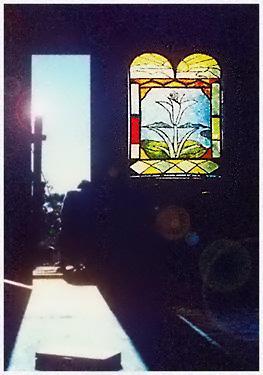 han mine, wore silly orange shorts, drove a beat-up pick up and had name cards that proclaimed himself as “artist?”
han mine, wore silly orange shorts, drove a beat-up pick up and had name cards that proclaimed himself as “artist?”
And so, growing up, this was how I knew him: through the cryptic messages on birthday cards. In the books I would steal from his shelves (Fyodor Dosteovsky, Jack Kerouac, Sylvia Plath). Through the music he listened to while painting, late at night. I would sip his coffee and stay up with him, later appropriating the music from his collection (Bob Marley, Tom Waits, Buena Vista Social Club). In the magazines he would send me from various trips abroad. In interviews of him I read in newspapers.
Through the various “long-hairs” hanging around him at his house, talking about politics, films, Erap jokes. Looking at his paintings in galleries, trying to understand what they meant. He loved dogs, and named them for artists: Pick-aso. Found Object. Untitled. (“Found Object! Come inside!”He would yell from the door of his house.)
He always tried to be a good dad. All of us, his children know we were adored. Whenever he sold a painting, he would always take us out to celebrate and give us huge amounts of money. Once, after he sold a big painting, he gave Diwata P5,000. Two days later, he called her back, asking to borrow money because he did not have enough to buy medicine. He had spent it all.
As I grew older, I grew smarter. My dad was a very complex, intelligent man—his works were a fusion of his skill, experimental methods, indigenous materials and ideas. He wasn’t just a “long-hair.” One important lesson I learned: at a performance, he walked around Baguio in a space suit, carrying a spray paint mechanism on his back. He spray painted his footsteps—over cars, sidewalks, grass and tree trunk—and left his mark everywhere. It was then that I learned: all boundaries and demarcations are imagined, and only art can set you free.
 By his example, I learned to be critical of my history–to reinterpret and reclaim what was taught to us in school into personal experiences. In my writing, I started looking to what was happening around me to “paint my own stories.” I hope my dad knows that I understand how he lived, that it was a good trade-off. It was worth it.
By his example, I learned to be critical of my history–to reinterpret and reclaim what was taught to us in school into personal experiences. In my writing, I started looking to what was happening around me to “paint my own stories.” I hope my dad knows that I understand how he lived, that it was a good trade-off. It was worth it.
Legacy
After his death, we cleared out his house and packed his things in boxes. A plaster hand, a Mao clock. A magic book, old election posters and journals. We tried to figure out what everything was, and what they meant to him. What was junk? What was not? It would have been easier if he weren’t an artist. His mother’s phonograph eventually found its way into an installation piece. His old dentures strung onto a corner of a painting. Chewed-up gum held together torn pictures of my sister. If my father were a banker, would it have been easier? Numbers, stocks, bank accounts are all easily cleared away and forgotten.

In an email to a friend, my father writes about the irony of promoting his art in a third world country. After a meeting with the director of the Metropolitan Museum, he says, “No luck, my works don’t fall to [sic] their priority programs which is water, urban renewal, and garbage. I am depressed that even my works don’t qualify under garbage.”
My dad could sit for hours in a corner of his studio, smoking. He said his girlfriend complained that he was lazy, and he would defend himself: “Even when I am just sitting here, I am working! I’m thinking about what I am going to put next in my paintings!” he would say. After he died, we collated a list of all his prints, paintings, installations, performances: the list it was more than a hundred pages on a size 10 font, with about 5,000 works.
There is no pain like losing a parent. Think a break up times a million. There grief wedged in your heart that makes you feel puke-y all the time, a perennially queasy stomach. The pain doesn’t end, either. Not after a year, or five, or 10. It just subsides, sometimes, then surges up again.
And there are many things I feel sad about now that my dad is dead. The fact that his grandkids will never know in person how funny he was. That he will never perform magic tricks for them. That he will never get to insult my boyfriends again. That I will never stay up til 3 a.m. in his house in Baguio, watching him work, listening to the Beatles.
These are all superficial things, I think. Because I also feel bad for Philippine art. That the country lost such a brilliant painter, art theorist, and organizer. That we are all deprived of seeing any more twisted, funny, stringently thought-provoking magical work by my father.
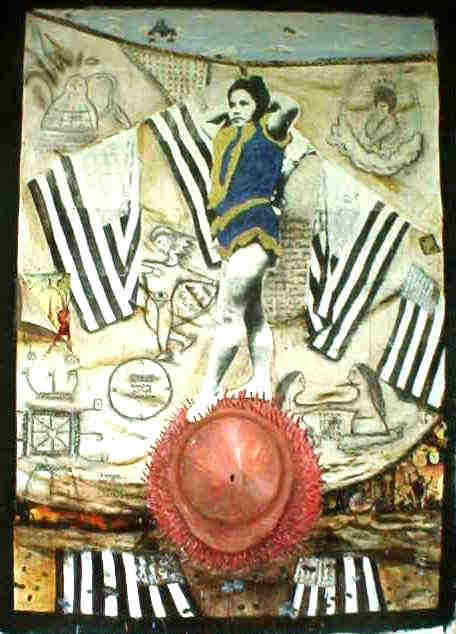
Last October, I performed at a booklaunch in San Francisco for an anthology I was in, “Coming Home to a Landscape.” Malou Babilonia let me stay at Pusod, her nonprofit arts center. I slept in a bedroom that displayed my dad’s painting. It was a huge painting, about 6×4 feet. It was a painting of schoolboys in a nipa hut. A white man is teaching them English. Andy Warhol’s Campbell soup on the wall. On another wall, an American flag. Above everything, anting antings and scenes from the Ginebra gin logo. St. Michael slaying the dragon.
It was called “To the person sitting in the darkness (with apologies to Mark Twain).” I couldn’t sleep, couldn’t breathe with his reds and blues and blacks and glitter and swirls and stripes and pictures and decals and crosses and saints and pig latin assaulting me.
In my eulogy I said that mostly what people remember is how funny he was. How he would say the craziest things. The thought that people would forget he was a brilliant artist scared me. But they won’t. Since his death, my whole family has received an outpouring of love from people who respected my dad’s work.
 Jessica Hagedorn dedicated her book, “Dream Jungle” to her “friend and cultural provocateur.” San Francisco-based poet Barbara Jane Reyes, has poems in her book “Gravities of Center” based on my dad’s paintings. Rene Ontal, a filmmaker in New York, talked about him incessantly. Many young artist—both in the Philippines and in various parts of America—come up to me and tell me how much they idolize my father, how big an influence he is to their work.
Jessica Hagedorn dedicated her book, “Dream Jungle” to her “friend and cultural provocateur.” San Francisco-based poet Barbara Jane Reyes, has poems in her book “Gravities of Center” based on my dad’s paintings. Rene Ontal, a filmmaker in New York, talked about him incessantly. Many young artist—both in the Philippines and in various parts of America—come up to me and tell me how much they idolize my father, how big an influence he is to their work.
What he wanted was 10 more years, to paint a hundred more paintings. I wish I had a way to recreate them, to write a hundred stories for him.
There are so many things I still want to know about my father. I want to know: how he loved his women, his country, his art.
And I see him everywhere: my dreams of him are in vivid Technicolor. I spend hours studying his paintings, trying to figure them out. I cannot step into a museum or gallery without thinking of him. I remember a gist of an Erap joke (his favorite text message to send) and I tear up. His old photos hijack me (of ex-girlfriends in the dogeared pages of A Hundred Years of Solitude, beneath a stack of old papers). I look around at airports: I see whole new worlds. There is art and humor. And magic.
I see him at the corner of my eye, in the curve of my thumb when I am reading poetry. I listen to myself, and I know he lives.
– Published in the Sunday Inquirer Magazine on March 7, 2004
